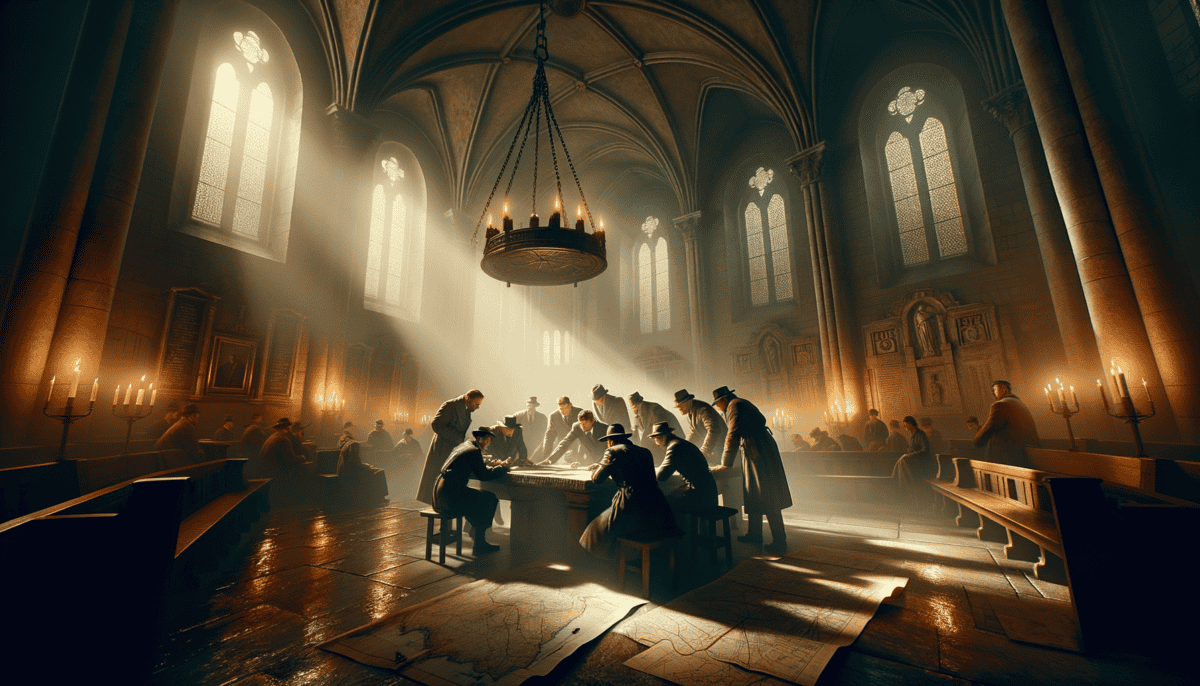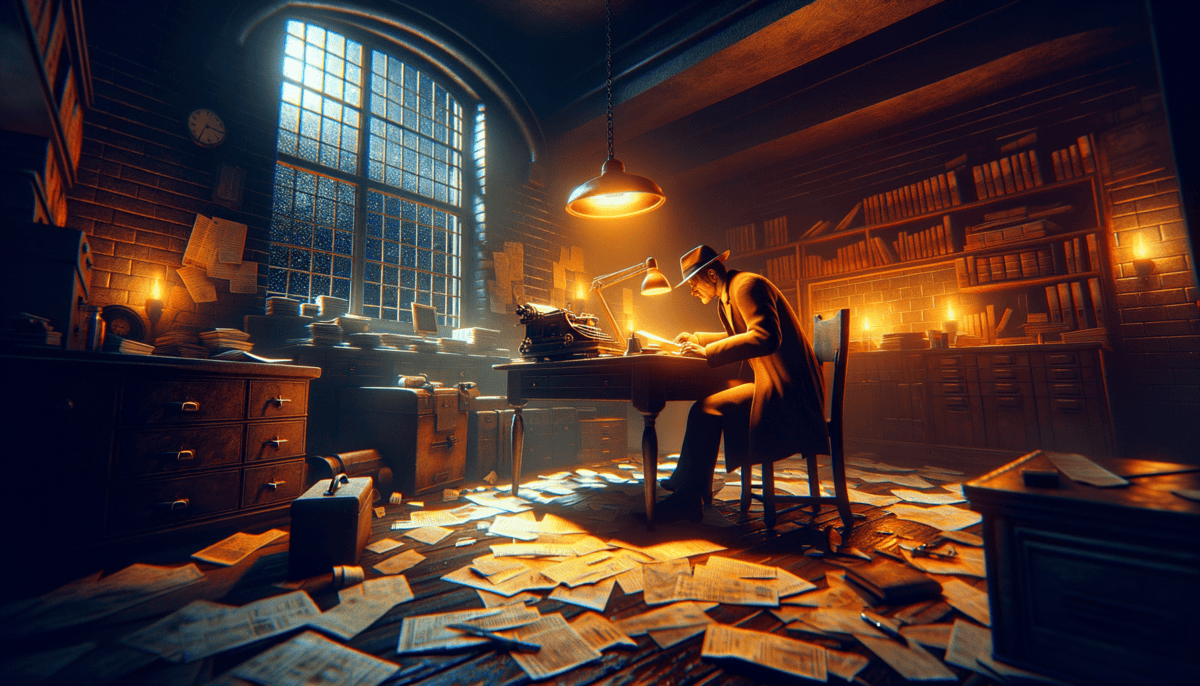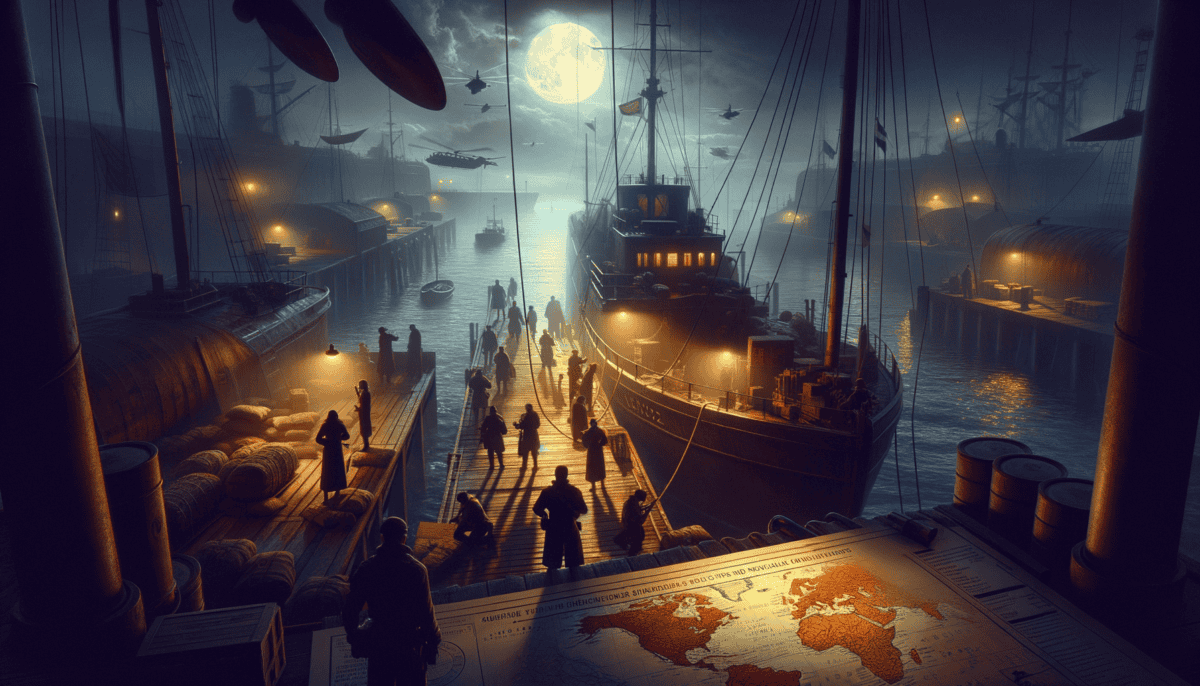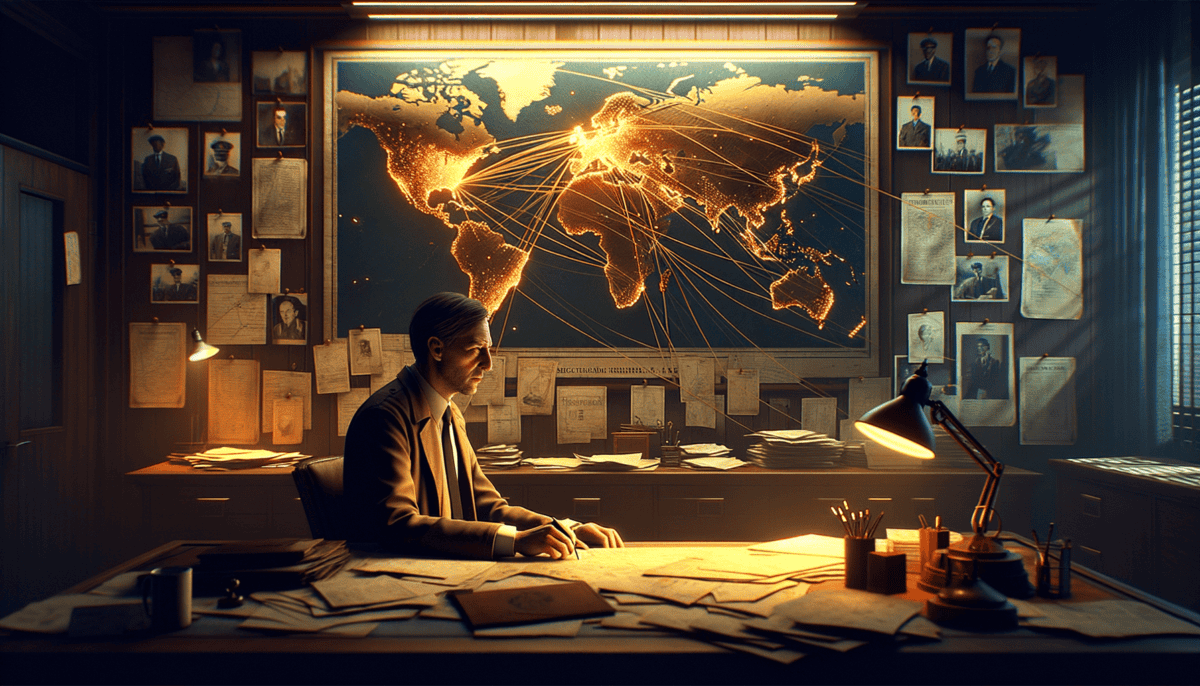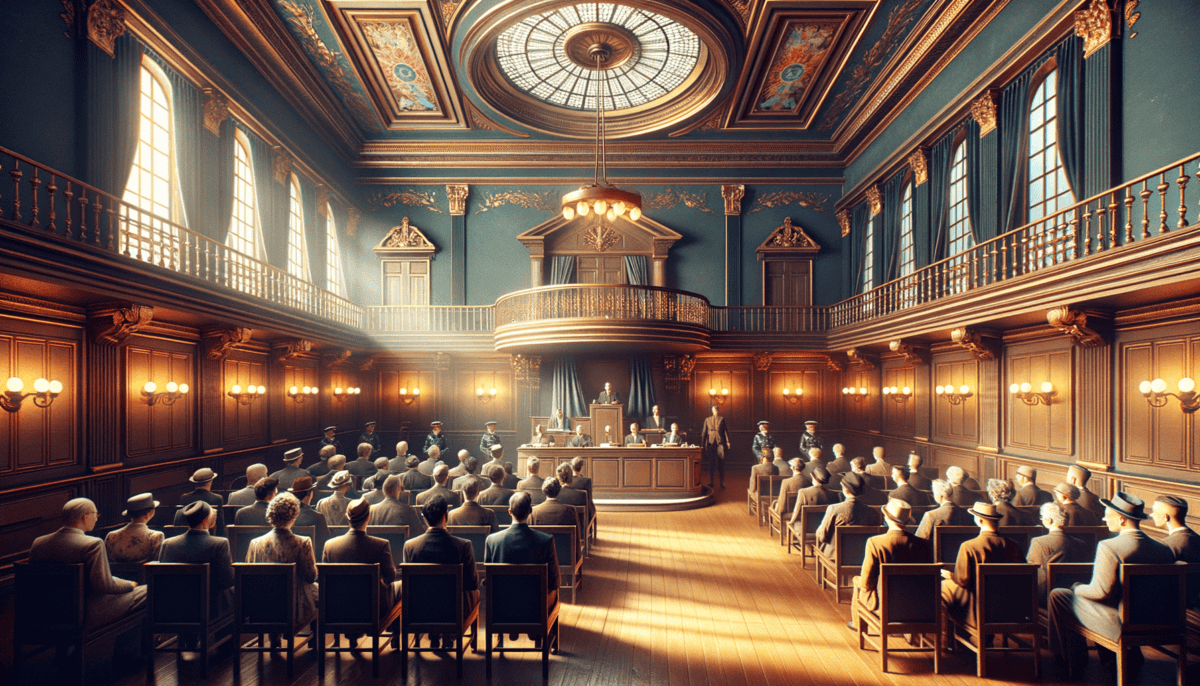The Crumbling Reich
The big grey walls of Hitler's bunker shook as bombs fell on Berlin. It was April 1945, and Nazi Germany was losing the war.
Martin Bormann paced back and forth in his office. His hands were shaking as he looked at the papers on his desk. As Hitler's right-hand man, he knew they were in big trouble. The Russians were coming from one side, and the Americans from the other.
"We need to leave now!" he shouted to his assistant, Hans. "Get me all the blank passports we can find!"
Outside, the streets of Berlin were full of scared people running away. The once-mighty Nazi leaders now looked like scared mice trying to hide. They knew the good guys were coming to catch them.
Heinrich Müller, the head of the Gestapo police, rushed into Bormann's office. His usually neat uniform was all messy.
"The Americans have crossed the Rhine," Müller said, wiping sweat from his face. "We have maybe two weeks before they reach Berlin."
Bormann nodded. He opened a big map on his desk. Red lines showed secret paths out of Germany. These paths would later be called "ratlines" – like the ropes rats use to climb onto ships.
"What about the gold?" Hans asked quietly.
"We've already moved it," Bormann whispered. "Swiss banks, Spanish vaults, and hidden places in South America. We'll have money when we get there."
The bunker shook again. Dust fell from the ceiling. In other rooms, Nazi officers were burning papers as fast as they could. They didn't want anyone to find their secret files.
One young officer looked at a picture of his family. “What will happen to us?” he asked.
“We’ll find a way out,” his friend said. “We always do.”
Outside Berlin, some smart Nazi leaders were already running away. They put on regular clothes instead of their uniforms. They changed their names. Some even pretended to be regular soldiers who didn't do anything bad.
Josef Mengele, the mean doctor from Auschwitz, had already left. He was wearing a Wehrmacht uniform and using a fake name. Nobody stopped him as he walked away from Berlin.
“Get rid of your uniforms,” Bormann told his men. “Burn your papers. From now on, we are different people with different names.”
The Nazi leaders made a list of things they needed:
• Fake papers and passports
• Regular clothes
• Money and gold
• Maps of escape routes
• Friends in other countries who would help them
As night fell over Berlin, more bombs lit up the sky like fireworks. But these weren't happy fireworks. They were the last lights of Hitler's Nazi Germany. The bad guys were losing, but many of them were already sneaking away in the dark.
Bormann looked at his watch. Time was running out. He had to choose: stay with Hitler in the bunker or run away to save himself. The walls shook again, and he made his choice.
"Pack everything," he told Hans. "We leave tonight."
As they walked through the dark streets of Berlin, Bormann and his men looked just like regular scared people. Nobody knew these men had helped do very bad things. They were starting their journey to far-away places where they thought nobody would find them.
But they were wrong. People would look for them for many years. And some of them would be found.
The Secret Escape Routes
In the summer of 1945, as the dust settled over Europe, a hidden network came to life. Catholic priests in Rome opened church doors late at night. These weren’t regular church meetings – they were helping Nazi officials escape!
Bishop Alois Hudal sat in his office at Santa Maria dell’Anima church. He looked at the man sitting across from him. The man wore simple clothes, but his stiff posture showed he used to be someone important.
“Your new name is Ricardo Klement,” Bishop Hudal said, sliding a red passport across his desk. “You’re going to Argentina.”
The ratlines worked like a big game of hide and seek. But this wasn’t a fun game – it was very serious. Bad people were trying to run away from being caught.
“How many have you helped?” the man asked.
“Enough,” Bishop Hudal answered. “The boats leave every month.”
In monasteries and churches across Italy, priests gave Nazi officials:
• New passports
• Different names
• Clean clothes
• Tickets to boats
• Places to hide
The Red Cross helped too, but they didn’t know they were helping bad guys. They gave out travel papers to many people after the war. Some Nazi officials pretended to be regular people who lost their homes.
In Spain, a man named Charles Lescat helped run another part of the ratline. He worked with a group called ODESSA. They helped Nazi officials get from Spain to Argentina on ships.
“The ships leave from Barcelona,” Lescat told his visitors. “President Perón in Argentina wants German workers. He doesn’t ask many questions.”
The escape routes were like a big spider web across Europe:
- From Germany to Austria
- Through the Alps to Italy
- Across Italy to Rome
- From Rome to Genoa or Barcelona
- By ship to Argentina
At each stop, different people helped the Nazi officials. Some did it because they still liked Nazi ideas. Others did it for money. And some, like Bishop Hudal, thought they were being kind Christians.
“Everyone deserves mercy,” Hudal would say. But he didn’t think about the many people the Nazis had hurt.
In the port of Genoa, ships left at night. The Nazi officials mixed in with other people leaving Europe. They carried their new passports and waited to start new lives far away.
One cold night, a ship called the North King left Genoa. On it was Adolf Eichmann, now called Ricardo Klement. He thought he would be safe in Argentina. But years later, some brave people would find him.
The ratlines stayed secret for many years. But bit by bit, people learned about them. They learned how the Nazi officials escaped and who helped them. It showed that even after the war, some people chose to help bad guys instead of doing what was right.
As more ships sailed away from Europe, the Nazi officials thought they were free. But they didn’t know that soon, brave Nazi hunters would start looking for them. The game of hide and seek wasn’t over – it was just beginning.
The Art of Disappearing
In a dark room in Munich, a man looked at himself in a mirror. His face was different now. He had shaved his mustache and dyed his hair brown. Even his best friend wouldn’t know him!
“Remember,” said the document maker, “your new name is Hans Schmidt. You were born in Austria. You lost your home in the war.”
Making new identities was like putting on a costume for a play. But this wasn’t fun make-believe. These were real Nazi officials trying to hide who they were.
• Names on papers
• Birth dates
• Where people were from
• Job histories
• Family information
Josef Mengele, a very bad doctor from the war, became Helmut Gregor. He got new papers that said he was a mechanic from South Tyrol. His friends wouldn’t call him Josef anymore.
“Your handwriting must change too,” the document maker said. “Write like someone who didn’t go to school for very long.”
The Nazi officials learned to look different:
- They grew beards or shaved them off
- They changed how they walked
- They wore worker’s clothes instead of uniforms
- They spoke different languages
- They made up new life stories
In Berlin, a special shop made fake stamps. These stamps made papers look real. The shop was hidden behind a bookstore. Only people with special passwords could get in.
“Every stamp must be perfect,” the shop owner said. “One wrong mark and everything fails.”
Sometimes, the Nazi officials pretended to be dead. They would find someone who died and take their name. This was very tricky and very wrong.
“Pick a common name,” advised one helper. “Nobody looks twice at a Hans or a Wilhelm.”
The Vatican gave out special papers called “Letters of Transit.” These papers helped people travel. Some Nazi officials got these papers by pretending to be good Catholics who needed help.
Living with a fake name was hard. The Nazi officials had to remember:
• Their new birthday
• Their fake family stories
• Where they said they were from
• What jobs they said they had
Klaus Barbie became Klaus Altmann. He practiced signing his new name for hours. He made up stories about being a simple farmer. But inside, he was scared someone would find out who he really was.
The document makers worked in secret places:
“We work at night,” one said. “During the day, we look like normal shops. At night, we make new lives for people.”
But living a lie was like carrying a heavy secret. Many Nazi officials jumped at loud noises. They worried someone would recognize them. They couldn’t even tell their children who they really were.
Some helpers taught the Nazi officials how to act in their new countries:
“In Argentina, drink mate tea. In Brazil, learn to love coffee. Fit in. Don’t stand out.”
As time passed, more and more Nazi officials changed who they were. They spread across many countries, hiding behind new names and faces. But paper and ink couldn’t hide the truth forever. Soon, brave people would start looking for them, following the clues they left behind.
The fake names and papers helped them hide for a while. But could they hide forever? As they sailed to new countries with their fake papers, they didn’t know that their past would catch up with them one day.
Safe Harbors and Shadow Lives
The big ships moved quietly in the night. On board, men with new names and faces looked toward South America. Argentina’s lights twinkled like stars in the distance.
“Welcome to your new home,” whispered Juan Perón’s helper. “Argentina will keep you safe.”
Josef Mengele, now called Helmut Gregor, stepped onto Argentine soil. He wore simple clothes and carried a small bag. No one would guess he was once a scary doctor from the war.
• Big German community
• Friendly government
• Lots of space to hide
• Far from Europe
• Easy to start new lives
Adolf Eichmann became Ricardo Klement. He got a job at a car factory. During lunch breaks, he ate empanadas and spoke Spanish with his workmates.
“Remember,” said his helper, “you’re just a simple worker now. No more giving orders.”
The journey to South America was long and scary. First, they went through Italy. Then they took boats from Spain. Some even went through special routes called “ratlines.”
“The sea is your friend,” said a Spanish captain. “It keeps your secrets.”
In Buenos Aires, German communities grew bigger. Old Nazi officials lived near each other, but pretended not to know one another. They met secretly in quiet cafes. ☕
Their new lives were different:
• Mengele worked as a farm helper
• Eichmann became a factory worker
• Klaus Barbie fixed cars
• Others became shopkeepers or farmers
But living in Argentina wasn’t always easy. They had to learn new things:
“Learn to dance the tango. Eat like an Argentine. Speak Spanish, not German, in public.”
Some Nazi officials went to other places too. Herbert Cukurs flew to Brazil. Josef Schwammberger hid in Chile. They spread out to make it harder for anyone to find them.
Their children grew up not knowing their fathers’ real names. Little Hans thought his dad was just a quiet mechanic. He didn’t know about the war or the bad things.
“Never talk about the past,” parents told their children. “We start fresh here.”
But some people couldn’t forget who they were. At night, they had bad dreams. During the day, they jumped when they saw cameras. They were always afraid someone would recognize them.
In small towns and big cities, they tried to blend in:
“Be boring,” their helpers said. “Boring people don’t get noticed.”
They built houses. They went to church. They had birthday parties. From the outside, they looked like normal families. But inside their homes, they kept old secrets.
Years passed. Argentina changed. New leaders came. The safe place wasn’t so safe anymore. And far away, people were starting to look for them. People who wanted justice.
Some Nazi officials thought they were finally safe. But they didn’t know that brave hunters were already planning to find them. Their new names and faces wouldn’t protect them forever. A storm was coming.
The Hunt Begins
Simon Wiesenthal looked at the wall of pictures in his tiny office. Each photo showed a different face – Nazi officials who ran away after the war. He had been searching for them for years.
“Every person who escapes justice is a wound that won’t heal,” Simon said softly.
In 1960, something big happened. Israeli spies found Adolf Eichmann in Argentina! They watched him come home from work every day. He thought nobody knew who he really was.
• Secret tips from neighbors
• Hidden cameras
• Brave spies
• Help from local people
• Lots of patience
The Mossad (Israeli secret agents) made a clever plan. They would grab Eichmann and take him to Israel. But they had to be very careful. ️
“We must bring him to trial,” said Isser Harel, the Mossad chief. “The world needs to know the truth.”
One evening, when Eichmann was walking home, the agents moved quickly. In just minutes, they caught him! They put him in a car and drove away. Nobody saw what happened.
“Are you Adolf Eichmann?” they asked him.
At first, he said no. But later, he told the truth. The man who thought he was safe in his new life was now caught.
More Nazi hunters joined the search. They worked day and night:
“We look for clues in old papers. We talk to people who might know something. We never give up.”
Beate Klarsfeld was another brave hunter. She and her husband Serge searched for Klaus Barbie, who was hiding in South America. They followed tiny clues like puzzle pieces.
Josef Mengele became very scared. He moved from place to place, always looking over his shoulder. He changed his name again and again. But the hunters were getting closer.
“They can run, but they can’t hide forever,” said Wiesenthal. “Justice has a long memory.”
The hunters used new tools: ️
• Special cameras
• Secret radios
• Fake passports
• Clever disguises
• Help from local police
Some people in South America started helping the hunters. They didn’t want bad people hiding in their towns anymore.
“These men must answer for what they did,” said a helper in Brazil. “It’s time for the truth.”
The Nazi hunters faced many problems. Some countries didn’t want to help them. Some people tried to stop them. But they kept working hard.
Simon Wiesenthal’s office got bigger. More helpers joined him. They made big maps showing where the hidden Nazis might be. Every day, they got new clues.
The hunters wrote books and made movies about their work. They wanted everyone to remember why catching these men was so important.
Regular people helped too. A man in Chile saw someone he thought was a hidden Nazi and told the police. A lady in Paraguay sent a letter with important information.
The hidden Nazis couldn’t sleep well anymore. They knew the hunters were coming. Some tried to run to new places. Others just waited, wondering when their turn would come.
But the biggest surprise was still coming. Nobody knew that one of the most important catches would happen because of a teenage girl who started asking questions about her family’s past.
Justice at Last
The warm Argentina sun set over Buenos Aires as an old man walked slowly down the street. He looked like any grandpa, but he was really Erich Priebke, a Nazi who had been hiding for almost 50 years.
“I thought everyone had forgotten,” Priebke muttered to himself.
But Priebke was wrong. A young reporter named Sam Donaldson found him! The reporter brought cameras and asked him hard questions about his past.
• Adolf Eichmann (1960)
• Klaus Barbie (1983)
• Josef Schwammberger (1990)
• Erich Priebke (1994)
• Dinko Sakic (1998)
Many of the hidden Nazis were now very old. Some died before they could be caught. Josef Mengele drowned while swimming in Brazil in 1979. He never faced justice for his bad deeds.
“Even if they’re old, they must answer for what they did,” said Eli Rosenbaum, a famous Nazi hunter. “Time doesn’t erase their crimes.”
The big trials began. People from all over the world watched on TV as these men finally had to tell the truth. Some said they were sorry. Others still said they did nothing wrong.
“The world must never forget,” said the judges at these trials.
Countries made new laws to catch bad people who try to hide. They promised to work together better. No more safe places for war criminals!
“We learned that justice might be slow, but it will come,” said a lawyer at the trials.
Young people started learning about what happened. Schools taught about the Nazi hunters and why their work was so important. Children wrote letters thanking the brave hunters.
Simon Wiesenthal kept working until he was very old. He helped catch over 1,100 Nazi officials! When he finally retired, other people promised to continue his work.
“Remember,” Wiesenthal often said, “for evil to win, good people just need to do nothing.”
Today, special teams still look for the last few hidden Nazis. But most are gone now. The biggest lesson remains: you can’t run from your past forever.
Museums now show the tools and maps the hunters used. Children visit these places and learn about bravery and justice. They learn that one person can make a big difference.
“The next generation must carry this memory,” said a museum guide. “So it never happens again.”
The story of how Nazi officials escaped after World War II, and how brave people caught them, changed how we think about justice. It showed that no matter where bad people hide, good people will find them.
And somewhere, in a quiet office, young investigators still look at old files and photos. They know there might be more secrets to uncover, more truth to find. The work of justice never really ends.


